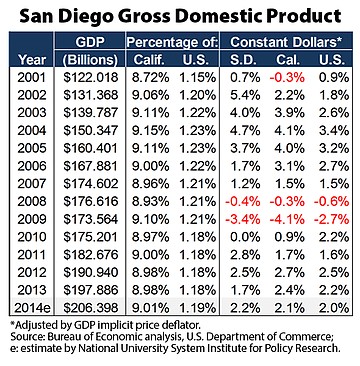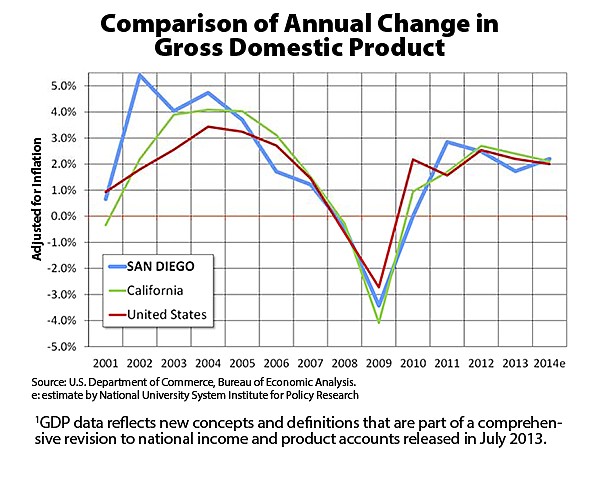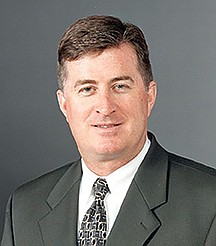 Facebook
Facebook
 X
X
 Instagram
Instagram
 TikTok
TikTok
 Youtube
Youtube



The world is a mess. San Diego might make money off that mess next year. Repeat: might.
Japan has gone into recession. Europe will likely follow. Wars are mushrooming all over: Middle East. Ukraine. Ghettos.
Economically, the United States has the least run-down house in a bad neighborhood. The Federal Reserve, our central bank, is keeping our economy afloat by printing money promiscuously. Despite the disaster of 2008–2009, Washington, D.C., is preparing to inflate housing again with lower buyer requirements. Profits of American corporations are doing well, but mainly because of financial engineering: with interest rates so low, companies borrow money cheaply and buy back their own stock, artificially inflating their earnings per share. They also juggle their books, stashing money abroad to avoid United States taxes and bolster earnings.
The stock market has roared upward since early 2009 because of the ocean of cheap money. Wall Street rejoices. The Federal Reserve keeps printing money, purportedly fearing deflation. But that money doesn’t get to Main Street, which is still hurting. In America, the top one-tenth of 1 percent now has as much wealth as the bottom 90 percent. So how could San Diego cash in next year? Well, government (mostly military) is 25 percent of the economy. Real estate — sales, rental, construction, mortgage activity — is another 20 percent.

The Pentagon has announced cutbacks. But the Marines and Navy — San Diego’s economic gravy train — won’t get derailed. “We’re headed back toward conflict,” says Marney Cox, chief economist for the San Diego Association of Governments. “With a new Republican Congress, there is an opportunity for additional defense programs.” The boost that San Diego gets from the military — troops, civilian employees, manufacturing — “at worst will be a stabilizer and most likely a growth sector” next year.
In recent years, the military concentrated much more of its activity in the western part of the U.S. There was a lot of construction at Camp Pendleton and elsewhere, “and that helped mitigate impacts on the construction industry and the sequestration slowdown,” says Cox.

And real estate? The Federal National Mortgage Association (Fannie Mae) and Federal Home Loan Mortgage Corporation (Freddie Mac), which together guarantee 90 percent of new mortgages, are loosening up lending standards, lowering the minimum down payment on a mortgage to 3 percent. That will help housing. But Fannie and Freddie almost went under in the 2008 calamity. Excessively easy home-lending standards were a major cause of the crisis. Looking at that 3 percent figure, Kelly Cunningham, economist for the National University System Institute for Policy Research, harrumphs, “We went through a bubble before, and now they are doing everything they can to reinflate that bubble.”
San Diego median home prices are close to $500,000, among the highest and least affordable in the nation. Prices were rising at 10 percent a year and above and now are rising at half that. Zillow.com thinks San Diego home prices will rise only 1.7 percent in 2015. Both Cox and Cunningham think prices can continue rising at a very moderate rate, but Cunningham is worried about that bubble bursting again.
For many years, San Diego had a surfeit of condos downtown. But some of the bigger projects shifted from condos to apartments. The high vacancy rate is finally coming down. “Now we have the ability to get something done downtown,” says Cox. “Now we have a neighborhood.”
San Diegans’ household incomes are a good deal higher than the nation’s but much lower than those in the Bay Area. Yet population continues to increase — not at the 3 percent annual rate of decades ago, but at 1 percent, which, at least, is double the rate of a few years ago. How can people afford homes? “Multi-generations are living together; you see multifamily homes and smaller-square-footage homes to overcome the affordability issue,” says Cox.
Residential real estate has rebounded from 2005–2006, when the bubble burst, but commercial real estate (such as hotels and office buildings) “hasn’t come back,” says Cunningham.
The San Diego unemployment rate has dropped from a peak of almost 11 percent in July of 2010 to below 6 percent. However, says Cunningham, “It is a two-tiered jobs growth. There are some solid, high-paying tech jobs but low-paying service jobs. There is not a big middle as in manufacturing and construction.” Indeed, tech (such as biotech, telecommunications, software) and aerospace represent about 11 percent of the county’s employment but 24 percent of payrolls. “The average tech pay is $115,000 versus $56,000 for all industries,” says Cunningham.
But, notes Cox, “The emerging technology industries are not growing fast enough to help San Diego out of the biggest impact from the Great Recession [late 2007–early 2009].” Venture capital, which gamey investors put into new companies, is running at about $1 billion a year. “Coming out of prior recessions, it was $2 billion a year.”
“Retailing still hasn’t recovered from the Great Recession,” says Cunningham, although there has been some increase of late. “This goes back to the two-tiered economy.” Buying by the super-upscale set is going gangbusters, but with middle incomes falling, adjusted for inflation, “people are not spending.”
Some do their buying on the internet. This factor is hurting shopping centers. “For a long time, the strip-mall side of retailing was really in bad shape. Now they are filling back up with different types of businesses — exercise studios, boxing and yoga establishments, for example,” says Cox.

Tourism has edged back, but only recently inched above its pre–Great Recession level, says hotel expert Jerry Morrison. San Francisco, Los Angeles, and Orange County have done much better. That will continue, he says.
This year, the San Diego economy grew by an inflation-adjusted 2.2 percent, beating California’s 2.1 percent and the nation’s 2 percent, says Cunningham. Cox is bullish for 2015: he thinks San Diego County can add “in the neighborhood of 30,000 jobs or more.” That would mean 2015 could keep pace with or do better than this year.
But Cunningham says the local growth rate will drop below 2 percent in 2015, as the United States also slows. “This whole thing with printing money, zero percent interest rates, big deficits — the chickens are coming home to roost,” and San Diego will feel the pain that the nation will suffer, he says.




The world is a mess. San Diego might make money off that mess next year. Repeat: might.
Japan has gone into recession. Europe will likely follow. Wars are mushrooming all over: Middle East. Ukraine. Ghettos.
Economically, the United States has the least run-down house in a bad neighborhood. The Federal Reserve, our central bank, is keeping our economy afloat by printing money promiscuously. Despite the disaster of 2008–2009, Washington, D.C., is preparing to inflate housing again with lower buyer requirements. Profits of American corporations are doing well, but mainly because of financial engineering: with interest rates so low, companies borrow money cheaply and buy back their own stock, artificially inflating their earnings per share. They also juggle their books, stashing money abroad to avoid United States taxes and bolster earnings.
The stock market has roared upward since early 2009 because of the ocean of cheap money. Wall Street rejoices. The Federal Reserve keeps printing money, purportedly fearing deflation. But that money doesn’t get to Main Street, which is still hurting. In America, the top one-tenth of 1 percent now has as much wealth as the bottom 90 percent. So how could San Diego cash in next year? Well, government (mostly military) is 25 percent of the economy. Real estate — sales, rental, construction, mortgage activity — is another 20 percent.

The Pentagon has announced cutbacks. But the Marines and Navy — San Diego’s economic gravy train — won’t get derailed. “We’re headed back toward conflict,” says Marney Cox, chief economist for the San Diego Association of Governments. “With a new Republican Congress, there is an opportunity for additional defense programs.” The boost that San Diego gets from the military — troops, civilian employees, manufacturing — “at worst will be a stabilizer and most likely a growth sector” next year.
In recent years, the military concentrated much more of its activity in the western part of the U.S. There was a lot of construction at Camp Pendleton and elsewhere, “and that helped mitigate impacts on the construction industry and the sequestration slowdown,” says Cox.

And real estate? The Federal National Mortgage Association (Fannie Mae) and Federal Home Loan Mortgage Corporation (Freddie Mac), which together guarantee 90 percent of new mortgages, are loosening up lending standards, lowering the minimum down payment on a mortgage to 3 percent. That will help housing. But Fannie and Freddie almost went under in the 2008 calamity. Excessively easy home-lending standards were a major cause of the crisis. Looking at that 3 percent figure, Kelly Cunningham, economist for the National University System Institute for Policy Research, harrumphs, “We went through a bubble before, and now they are doing everything they can to reinflate that bubble.”
San Diego median home prices are close to $500,000, among the highest and least affordable in the nation. Prices were rising at 10 percent a year and above and now are rising at half that. Zillow.com thinks San Diego home prices will rise only 1.7 percent in 2015. Both Cox and Cunningham think prices can continue rising at a very moderate rate, but Cunningham is worried about that bubble bursting again.
For many years, San Diego had a surfeit of condos downtown. But some of the bigger projects shifted from condos to apartments. The high vacancy rate is finally coming down. “Now we have the ability to get something done downtown,” says Cox. “Now we have a neighborhood.”
San Diegans’ household incomes are a good deal higher than the nation’s but much lower than those in the Bay Area. Yet population continues to increase — not at the 3 percent annual rate of decades ago, but at 1 percent, which, at least, is double the rate of a few years ago. How can people afford homes? “Multi-generations are living together; you see multifamily homes and smaller-square-footage homes to overcome the affordability issue,” says Cox.
Residential real estate has rebounded from 2005–2006, when the bubble burst, but commercial real estate (such as hotels and office buildings) “hasn’t come back,” says Cunningham.
The San Diego unemployment rate has dropped from a peak of almost 11 percent in July of 2010 to below 6 percent. However, says Cunningham, “It is a two-tiered jobs growth. There are some solid, high-paying tech jobs but low-paying service jobs. There is not a big middle as in manufacturing and construction.” Indeed, tech (such as biotech, telecommunications, software) and aerospace represent about 11 percent of the county’s employment but 24 percent of payrolls. “The average tech pay is $115,000 versus $56,000 for all industries,” says Cunningham.
But, notes Cox, “The emerging technology industries are not growing fast enough to help San Diego out of the biggest impact from the Great Recession [late 2007–early 2009].” Venture capital, which gamey investors put into new companies, is running at about $1 billion a year. “Coming out of prior recessions, it was $2 billion a year.”
“Retailing still hasn’t recovered from the Great Recession,” says Cunningham, although there has been some increase of late. “This goes back to the two-tiered economy.” Buying by the super-upscale set is going gangbusters, but with middle incomes falling, adjusted for inflation, “people are not spending.”
Some do their buying on the internet. This factor is hurting shopping centers. “For a long time, the strip-mall side of retailing was really in bad shape. Now they are filling back up with different types of businesses — exercise studios, boxing and yoga establishments, for example,” says Cox.

Tourism has edged back, but only recently inched above its pre–Great Recession level, says hotel expert Jerry Morrison. San Francisco, Los Angeles, and Orange County have done much better. That will continue, he says.
This year, the San Diego economy grew by an inflation-adjusted 2.2 percent, beating California’s 2.1 percent and the nation’s 2 percent, says Cunningham. Cox is bullish for 2015: he thinks San Diego County can add “in the neighborhood of 30,000 jobs or more.” That would mean 2015 could keep pace with or do better than this year.
But Cunningham says the local growth rate will drop below 2 percent in 2015, as the United States also slows. “This whole thing with printing money, zero percent interest rates, big deficits — the chickens are coming home to roost,” and San Diego will feel the pain that the nation will suffer, he says.
Comments